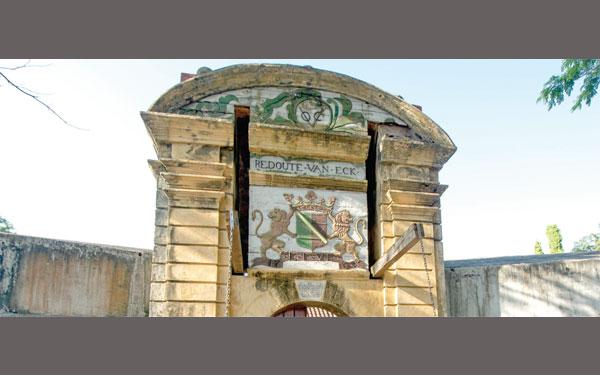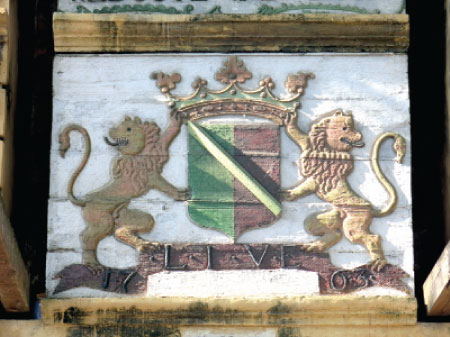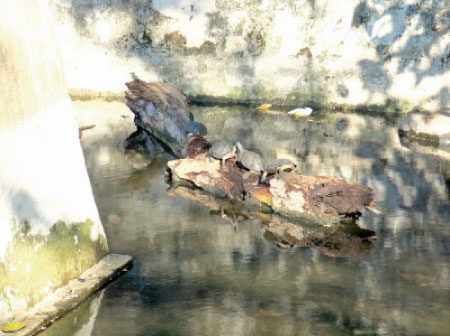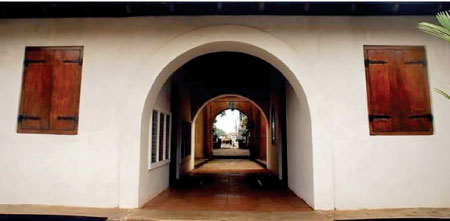
Matara is close to the southernmost point of Sri Lanka and it’s about 170 kilometres from Colombo. Matara has a history going back over 2,000 years but modern Matara became an important city only during the Dutch occupation as it was used as a main port for the exportation of cinnamon and elephants.
There are a number of Forts in Sri Lanka which were built by foreign invaders. Among them, the Matara Star Fort has a significant place. The Star Fort, Matara is opposite the Matara Urban Council Office. This was the last defensive structure by the Dutch in Sri Lanka.
Name
The Star Fort got its name from its shape as it was made in the shape of a six-point star.
 |
| The plaque of the Fort above the archway of the entrance |
 |
The moat as seen today with tortoises crawling above the water |
| The courtyard inside the Fort |
The only Fort in Sri Lanka, built in the form of a star it has its own historical importance and stands in the town of Matara, close to the Matara Dutch Fort.
In 1760, the ‘Matara Rebellion’ took place and this Fort came up after the Sinhala army attack on Matara.
By March 1761, the Kandyan forces and the rebellious lowlanders had occupied the Fort. In 1762, the Fort was retaken by the Dutch. As a result of the rebellion, Matara was reinforced by the building of the Star Fort, standing on the west bank of the Nilwala Ganga.
Baron von Eck
The building of this structure was started in 1763 and completed in 1765 by Baron Van Eck, the Dutch Governor who invaded Kandy in 1765. The Star Fort was used to house a small garrison of Dutch troops. Meant as an artillery position, it was built in the shape of a six-pointed star. Its guns could cover the approaches from all directions.
At one time, the Fort was surrounded by a deep ditch.
The gate
The gate is a splendid example of Dutch colonial architecture. A semi-circular ‘frame’ ornamented with the VOC initial, forms the top portion of the archway, this is supported on either side by two square pillars.
Captioned centrally beneath this is the name of the Fort, Redoute Van Eck. Immediately below, there is a plaque with van Eck’s coat of arms, flanked by two lions.
On either side of the slab are two long, narrow slots into which the beams of the now extinct drawbridge retracts. On the outside, the keystone of the gate arch bears the inscription As De Lij, Opperkoopman en secunde van het Gaals Commant mitsgs. Dessave deeser landen, AO MDCCLXV’.
In 1796 the Star Fort fell into the hands of the British. It was used as the residence of the engineer and was maintained by the Public Works Department. From 1965 the Urban Council used the Star Fort as the Matara Public Library and in 1980 it was taken over by the Department of Archaeology.
The moat which surrounded the Fort was filled with earth but was later excavated and renovated by the Department of Archaeology and a new drawbridge was installed.
The interior of the Fort where the canons were located, the six gun point at six different directions was also renovated. A hexagonal-shaped building was constructed in keeping with the shape of the Fort with a hexagonal courtyard. The Stat Fort was the last major defensive work by the VOC in Sri Lanka.
It has become a much-visited place for many travellers and history students. The construction date (1765) is imprinted over the main gate, along with the VOC company insignia and the coat of arms of the Governor of the day. The two carved lions guard the entrance gates of the Fort.
You can also spot the slots that once secured the drawbridge beams.
